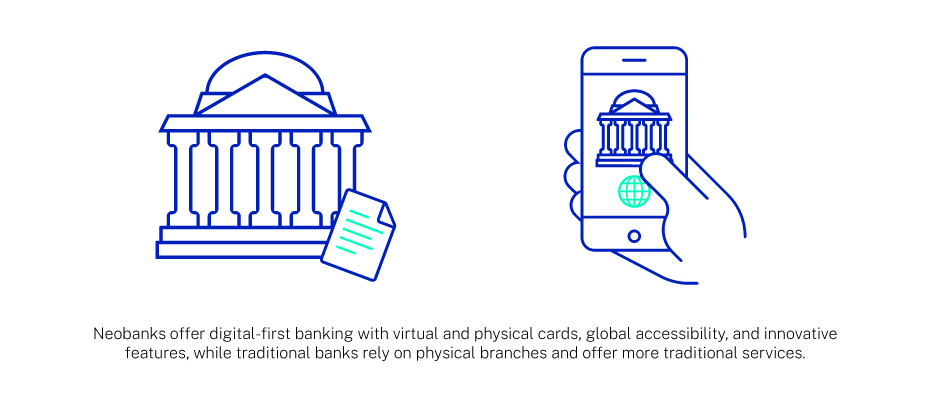Shaping the Future of Neobanking: Challenges and Pathways to Success
Mark Westbrook
Key Takeaways:
- Neobanks largely struggle with developing and monetizing unique and substantial alternatives.
- GenAI can cover simpler marketing content tasks and more complex transaction security tasks.
- AI in general makes neobanking services more secure, accessible and cost-efficient.
Introduction
Neobanks, with their digital-first approach, are transforming the banking sector, offering users seamless financial services. However, this rapid evolution brings its own set of challenges. Understanding these challenges and exploring effective solutions is crucial for sustaining growth and achieving long-term success.
The Rise of Neobanks
Neobanks emerged as a response to a significant shift in consumer trust and demand post-2000s global banking crisis. With traditional banks struggling, a demand for more transparent, accessible, and customer-centric banking solutions rose. Neobanks, leveraging digital technology, filled this void starting in 2010, offering online and app-based services focused on superior customer service and flexible banking. Their growth prompted traditional banks to innovate digitally, a trend further accelerated by the COVID-19 pandemic, highlighting the critical need for digital banking solutions in a changing world.

Key Drivers Behind the Success of Neobanks
Building on the foundation laid in the aftermath of the global banking crisis, the success of neobanks can be attributed to several key drivers:
 Digital Innovation:
Digital Innovation:
Neobanks have capitalized on the latest technologies to offer seamless, user-friendly banking experiences. Their platforms integrate cutting-edge features that traditional banks have been slower to adopt, making banking more intuitive and accessible.
 Customer Expectations:
Customer Expectations:
Today's consumers, especially millennials and Gen Z, expect banking to be as agile and convenient as other online services. Neobanks have met these expectations by offering real-time transactions, personalized financial insights, and 24/7 access through mobile apps. Market Opportunities:
Market Opportunities:
The financial crisis not only diminished trust in traditional banks but also opened up market opportunities for new entrants. Neobanks seized this moment to redefine banking, presenting themselves as transparent, customer-focused alternatives.These drivers have not only fueled the rise of neobanks but also forced the entire banking sector to evolve. Traditional banks, recognizing the shift in consumer preferences and the competitive threat posed by neobanks, have begun to prioritize digital innovation and improve their online and mobile banking services. This convergence of factors has accelerated the digital transformation across the banking industry, making digital-first banking the new standard.
Business Challenges Faced by Neobanks
As neobanks capitalized on digital innovation, consumer demand for agile services, and the opportunities presented in the post-crisis market, they have encountered a new set of challenges inherent to their rapid development and the changing banking ecosystem.
 Differentiation and Customer Acquisition:
Differentiation and Customer Acquisition:
Neobanks face intense competition, not only among themselves but also from traditional banks moving into the digital space. The challenge lies in differentiating their offerings and acquiring customers in a saturated market. Monetization Strategies:
Monetization Strategies:
Neobanks struggle with developing sustainable revenue models. Despite having large customer bases, many neobanks have not yet found a way to monetize these effectively, relying heavily on venture capital for growth. Regulatory Compliance and Trust:
Regulatory Compliance and Trust:
Neobanks face regulatory hurdles, along with the challenge of building trust among consumers used to traditional banking institutions. Technology and Innovation:
Technology and Innovation:
Maintaining cutting-edge technology platforms that ensure security, scalability, and innovation is identified as a challenge as well. The fast-paced nature of technological evolution demands constant updates and improvements.Solutions for Success
By focusing on the following solutions, neobanks can address the immediate challenges of differentiation, customer acquisition, monetization, regulatory compliance, and technological innovation. Success in these areas will not only solidify the position of neobanks in the competitive market but also ensure they remain at the forefront of the banking revolution.
 Enhanced Differentiation and Customer Experience:
Enhanced Differentiation and Customer Experience:
Implementing AI and machine learning for personalized banking experiences can significantly enhance customer retention and acquisition. Tailored financial advice, predictive analytics for spending habits, and customized offers help in standing out in the crowded marketplace. Diverse Monetization Strategies:
Diverse Monetization Strategies:
The key is the transition in the strategy of neobanks from focusing primarily on customer acquisition to emphasizing profitability. This shift recognizes the importance of leveraging large customer bases to generate more revenue per user, offering premium subscriptions, increasing lending income, and enhancing cross-selling opportunities. Navigating Regulatory Compliance and Building Trust:
Navigating Regulatory Compliance and Building Trust:
Adopting agile and secure technology infrastructures can help neobanks stay competitive and address scalability and security concerns, while adapting to global financial regulatory standards and ensuring customer data protection can help with building trust of the customers.  Keeping Pace with Technology and Innovation:
Keeping Pace with Technology and Innovation:
The need for differentiation and monetization implies that innovation in product development is key. This includes offering unique banking services or features that meet specific customer needs and preferences. Addressing this, the involvement of a product discovery methodology becomes a strategic solution, identifying opportunities for neobanks to innovate and differentiate effectively in the market.
How AI Improves Neobanking
AI supports comprehensive solutions to differentiation and customer acquisition challenges. For starters, it helps balance automated customer support with personalized customer experiences at scale. Consequently, customers get the most relevant marketing communications, offers and assistance before, during and after the transaction journey
AI also underpins greater data analytics capabilities, enabling neobanking teams ascertain how to reach and serve different customer profiles. It adds value to various services, such as optimizing investment strategies based on portfolio performance, evolving client demands and business targets. AI Increases operational efficiency and minimizes errors by automating risk assessment, loan approvals and other transaction processes.
Additionally, AI algorithms comb through large volumes of transaction data to detect anomalies and identify obscure patterns that could point to fraudulent activity. AI also underpins various transaction security measures such as dynamic CVVs and OTPs. This helps address data protection-related compliance.
The Future Development of Neobanks
The trajectory of neobanks from filling a market void left by traditional banks to becoming frontrunners in digital banking innovation illustrates a natural progression. The very factors that have fueled their rise—technological prowess, market agility, and consumer-centric models—have also set the stage for the current hurdles they face.
As neobanks navigate these challenges, their ability to innovate, adapt, and strategically address each hurdle will not only determine their individual success but also continue to shape the future landscape of the banking industry.
Connect with our team today to uncover tailored solutions that address your unique challenges and accelerate your path to digital banking success. Let's shape the future of banking together.
You may also like
Subscribe to receive our exclusive newsletter with the latest news and trends
Subscribe to receive our exclusive newsletter with the latest news and trends
Want to reach out directly to us?
hello@ciklum.com
© Ciklum 2002-2023. All rights reserved



.png?width=1000&height=315&name=contact-us-CTA%20(2).png)
